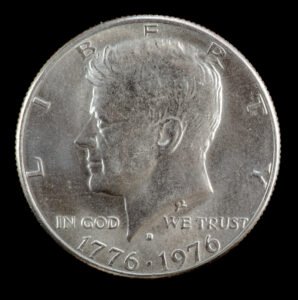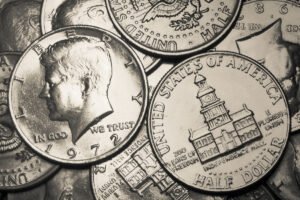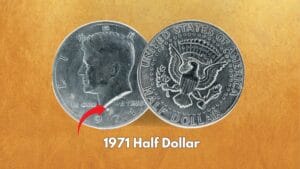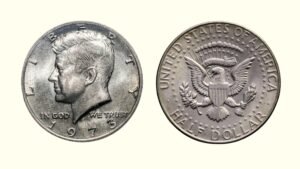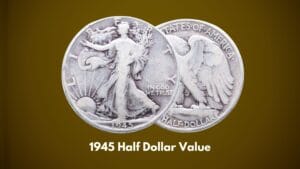Imagine finding a coin in your pocket worth 10,000 times its face value. It might sound like a dream, but it can become a reality for some lucky owners of the 1776-1976 Kennedy Half Dollar! That’s true! While most of the 1976 Bicentennial Half Dollar coins are worth their 50-cent face value, a few rare examples have sold for an astounding $5,000 or more!
So, what makes the difference between a common 1976 50-cent coin and a hidden gem? In this article, I’ll tell you the secrets to finding a valuable 1976 Half Dollar and surprising factors that can turn 50 cents into a small fortune.!
1776-1976 Bicentennial Kennedy Half Dollar History
To commemorate the United States Bicentennial, which marked 200 years since the signing of the Declaration of Independence in 1776, the U.S. Mint produced special designs for the quarter, half-dollar, and dollar coins. The 1976 Half Dollar is a part of this special program, which makes it special!
These coins were unique in that they bore the dual date of 1776-1976, setting them apart from regular issues. As for the 1976 Half Dollar, it featured a redesigned reverse by Seth Huntington, depicting Independence Hall in Philadelphia.
Production of these commemorative half-dollar coins began in 1975 and continued through 1976, resulting in a large mintage that ensured wide circulation and availability for the American public.
| 1976 Bicentennial Half Dollar | Key Facts |
| Coin Composition | 75% Copper, 25% Nickel over a pure Copper center; 40% Silver, 60% Copper (proof & Uncirculated) |
| Minting Location | Philadelphia, Denver, San Francisco |
| Year of Minting | 1976 |
| Weight | 11.34 grams |
| Diameter | 30.6 mm |
| Thickness | 2.15 mm |
| Designer | Gilroy Roberts/Frank Gasparro |
| Face Value | $0.50 (50 cents) |
| Mint Marks | No Mint Mark – Philadelphia Mint, D – Denver Mint S – San Francisco Mint |
| Total Mintage | 543,932,347 coins |
How to Identify a 1976 Kennedy Half Dollar (Design & Composition)
You can easily spot a 1976 Half Dollar by examining its unique design elements on both sides and its physical characteristics:
1976 Half Dollar Obverse Design:
- Portrait of President John F Kennedy facing left
- The inscription “LIBERTY” along the top edge
- The dual date “1776-1976” below Kennedy’s neck
- “IN GOD WE TRUST” to the left of Kennedy’s portrait
- The mint mark (if present) below Kennedy’s bust
1976 Half Dollar Reverse Design:
- Independence Hall in Philadelphia at the center
- “UNITED STATES OF AMERICA” along the top edge
- “HALF DOLLAR” along the bottom edge
- “200 YEARS OF FREEDOM” above Independence Hall
- “E PLURIBUS UNUM” below Independence Hall
Coin Composition and Dimensions:
The 1976 Half Dollar was released in two different compositions:
- Copper-nickel Clad: For circulation coins, the United States Mint used the standard copper-nickel clad composition, consisting of an inner core of pure copper between outer layers of 75% copper and 25% nickel.
- Silver-clad Copper: For collector editions, the Mint produced 11,000,000 half dollar coins with an outer layer of 80% silver and 20% copper bonded to an inner core of 79% copper and 21% silver, resulting in % overall silver content of 40%.
Regardless of its composition, the 1976 Kennedy Half Dollar weighs 11.34 grams and has a diameter of 30.61 mm (1.205 inches). The coin’s thickness is 2.15 mm (0.085 inches), and it features a reeded edge.
4 Key Factors to Find the 1976 Half Dollar Value
On average, a 1976 Half Dollar in the circulated condition is worth its face value of 50 cents to $1. However, uncirculated coins or those with rare characteristics can range from $5 to several hundred dollars, with some exceptional examples fetching thousands.
Let’s understand what factors and fractures really impact your 1976 Half Dollar coin value!
1. Coin Grading and Condition:
The condition of a 1976 Half Dollar is the first thing that determines its true value. Generally, 1976 half-dollar coins in excellent, new-like condition are worth the most, while average or poor-condition coins fetch minimal prices.
Professional grading services use a scale from 1 to 70, with 70 being a perfect, flawless coin. For 1976 half dollars, coins graded MS-67 (Mint State 67) or higher are worth $500 to $2,000 or more!
2. Mint Marks & Mintage
The mint mark on a 1976 Kennedy Half Dollar indicating its rarity is another crucial factor in assessing its worth. The lower the mintage, the rarer and more valuable the coin.
The total mintage for 1976 Kennedy Halves was 532,873,248 coins, which makes it common. But coins from certain mints can be special. You can identify the mint location by the mint mark located on the obverse:
- 1976 Half Dollar No Mint Mark: The 234,308,000 Philadelphia-minted 19776 half dollar coins have no mint mark and are generally the least valuable. In uncirculated condition, these coins are worth $1 to $5, with high-grade examples fetching $400 to $1,500 or more.
- 1976 D Half Dollar: The Denver Mint struck 287,565,248 1976 half dollar coins, identified by a small “D” mint mark. They are slightly more common than Philadelphia coins but have similar values, ranging from $1 to $5 in uncirculated condition and $2,500 or more for high mint grades, like MS-67+.
This 1976 Half Dollar value chart will help you find your coin’s average value based on its condition and mint marks!
| Coin Grades | Condition Details | 1976 No Mint Mark Half Dollar Value | 1976 D Half Dollar | 1976 S Half Dollar (40% Silver) |
| Poor (0) to Extremely Fine (XF45) | Significant wear, faded but visible details | 50 cents to $1 | 50 cents to $1 | 50 cents to $1 |
| Almost Uncirculated (AU50) to Mint State (MS60) | Slight wear on highest points, visible marks or blemishes | $1 – $5 | $1 – $5 | Around $5 |
| Mint State (MS61 – MS64) | Uncirculated with minimal wear | $5 – $20 | $5 – $20 | $5 – $15 |
| Mint State (MS65 – MS66+) | Nearly flawless with very minor imperfections | $15 – $200 | $10 – $60 | $15 – $30 |
| Mint State (MS67 – MS67+) | Well-preserved with no major flaws | $500 – $5,000+ | $200 – $2,500+ | $20 – $60 |
| Mint State (MS68 or Above) | Nearly perfect, luster, no major marks or flaws | N/A | N/A | $150 – $9,500+ |
3. 1976 Half Dollar Proof & Uncirculated Coins
The San Francisco Mint produced three types of special 1976 half dollars for collectors: “Clad Proof Coins,” “Silver Proof Coins,” and “Uncirculated Silver Coins.”
1976 Half Dollar Clad Proof Coins
These 7,059,099 1976 half dollar proof coins produced by the San Francisco have the regular clad composition. They are generally worth only $10 – $20 in highest PR grades, such as PR69, due to their composition.
1976 Silver Half Dollar Proof Coins
A total of 4,000,000 half-dollar proof coins with a 40% silver composition were struck in San Francisco. The average value of these proof coins ranges from $5 to $30 in uncirculated condition, with PR70 examples valued up to $2,500 or more.
Uncirculated 1976 Silver Kennedy Half Dollar
San Francisco produced 11,000,000 uncirculated 1976 half-dollar coins with a 40% silver composition. These half dollars are the most valuable of all 1976 Kennedy Half-Dollar coins, worth $2 to $10 in uncirculated grades. High-grade coins fetch $5,000 to $9,000 or more, like this MS69 example that sold for $9,600 on Heritage Auctions.
4. Rare Mint Errors & Varieties of 1976 Kennedy Half Dollar

Mint errors or varieties with anomalies can significantly increase your 1976 half-dollar coin’s value. Here are some notable errors to look for in 1976 Half Dollars:
Double Die Error
This error occurs when the coin die receives multiple impressions at slightly different angles during its creation. To spot this error coin, look for doubling on lettering, date, and design. The value of a 1976 half-dollar with double die error ranges from $30 to $200, depending on the coin’s condition and doubling.
Curved Clip Error
This error happens when one or more portions of the blank planchet get clipped off, resulting in a 1976 half-dollar coin with missing parts of its edge. Depending on the error’s visibility and the coin’s condition, a 1776-1976 Bicentennial Half-Dollar coin with a curved clip error can fetch between $20 and $150 at auction.
For example, an MS62 example with Curved Clip at 11 O’Clock sold for over $25, while an MS65 example with Triple Curved Clips error sold for over $110 on Heritage Auctions.
Reverse Lamination Error
Mint errors are caused by a foreign substance contaminating the coin blank during minting, leading to the cracking or chipping of metal on coin’s reverse. You can identify this error coin by varying colors on the reverse. One example of a 1976 Kennedy Half Dollar with a reverse lamination error sold for almost $500 on Heritage Auctions, highlighting its potential value.
Off-center Strikes
This error occurs when the 1976 Half Dollar planchet is not properly centered between the dies during striking. As a result, a part of the design might be missing, and a blank crescent might appear on the coin.
Depending on the degree of misalignment, a 1976 Bicentennial Half Dollar coin can be worth $25 to $1,000 or more. If an off-center half-dollar has other mint errors, it can be worth even more. For example, an MS64 example struck 45% Off Center with Reverse Mirror Brockage sold for a stunning price of $2,300!
Wrong Planchet Error
This is an extremely rare 1976 half-dollar error, where the coin is struck on a planchet intended for another denomination. Collectors highly seek out these errors. I found this rare 1976 half-dollar coin struck on a five-cent planchet that sold for a whopping $3,360 on Heritage Auctions.
Reverse Mirror Brockage
The 1976 Bicentennial Kennedy Half Dollar reverse mirror blockage mint error occurs when a previously minted coin doesn’t eject properly when a new blank planchet is struck. This results in a rare coin that features a mirror image of the original design on one side.
For instance, instead of the usual left-facing portrait of President Kennedy, the brockage error may show the portrait facing right. One example of this error is an MS63 1976 Bicentennial Half Dollar that sold for $2,115 on Heritage Auctions. The value can vary based on the quality of the brockage and the overall condition of the coin.
4 Steps to Identify a Fake Bicentennial Half Dollar Coin
- Check the Weight: Use a precise scale to ensure your 1976 half dollar coin weighs 11.34 grams. Any deviation indicates a counterfeit.
- Verify the Composition: Make sure that the Bicentennial Half Dollar coin has the original composition, especially for silver half dollars. Use a magnet; if the coin reacts, it’s like a fake.
- Examine the Edge: The edge of a 1976 Kennedy half dollar should be reeded and uniform, without signs of seams or joining.
- Check the Mint Mark: Ensure the mint marks, s or d, are correct and properly positioned. Fake coins may have forged S mint marks, as 1976-S 50C coins are valued more.
For high-value specimens, consider getting the coin authenticated by a reputable grading service.
As we saw above, while most 1976 Half Dollars are worth around 50 cents, certain factors can make them highly collectible. All you need to do is keenly observe these factors and rare characteristics and identify them using this price guide!
Just like the Bicentennial Half Dollar, the 1776-1976 Bicentennial Quarter Dollar coin is another highly collectible coin that’s greatly sought-after by coin collectors. Want to find out its true worth? Hop on to my detailed value guide now!
Note: This article is intended for informational, educational, and entertainment purposes only. Some images are illustrative and may not represent actual brands, products, or related entities. All trademarks, product names, brand logos, packaging, and other intellectual property referenced remain the exclusive property of their respective owners. Any brand mentions or references are provided solely for descriptive and educational context and do not imply any formal or commercial association.

